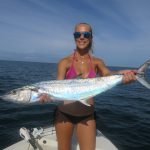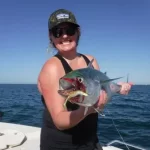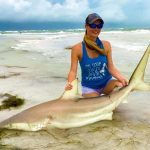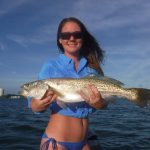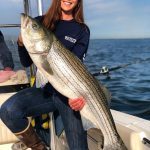Florida Saltwater Fishing in Winter; Species, Strategies, and Tips
This post will focus on Florida saltwater fishing in winter. While Florida is warmer than the rest of the country, we do experience winter. Fish migrations and feeding patterns change as well. Successful anglers understand these patterns and adapt to them. Winter fishing in Florida is about the weather, pure and simple. It is not unusual for it to be 78° with sun and a light breeze one day then cold and windy a couple days later. The key to being successful when Florida inshore winter fishing is adapting to the changing conditions. Florida fish species have both local and seasonal migrations. Anglers that understand these migrations will have more success. Many species are available to Florida anglers fishing in winter. These species would include;
- speckled trout
- snook
- redfish
- sheepshead
- jack crevalle
- snapper
- flounder
- bluefish
- grouper
- ladyfish
- black drum
Florida saltwater fishing in winter – tackle
Tackle for anglers Florida inshore winter fishing is pretty basic. A 7 foot medium action spinning rod with a 3000 series reel spooled up with 20 pound braid or 10 pound monofilament line will catch all but the largest inshore fish. Most anglers use a shock leader of 24 inches to 30 inches with 30 pound test being a good all-around strength.
Anglers can shop at Amazon for a Daiwa Black Gold reel and St Croix Triumph 7′ MF rod spinning combo in this link.
Both live bait and artificial lures produce in the wintertime. The days of cast netting pilchards and other bait fish on the flats are over. Capt Jim has been a fishing guide in Sarasota, Florida since 1991. Anglers who are interested in purchasing the equipment that he uses and writes about in his articles can do so on the PRODUCTS page. Live shrimp are by far the most popular and most productive live bait. The lead head jig and grub combination is the most widely used artificial lure. As water temperatures drop, fish metabolisms slow down. Therefore, angler presentations need to be slower and more deliberate as well. For that reason, jigs are extremely productive in the winter. Fish will often stage in holes in channels and other deeper areas. A jig slowly bounced along the bottom is a very natural presentation.
Florida winter weather patterns affect fishing
Florida experiences cold fronts every week or so in the winter. The cycle is as follows. As the front move through, the wind will blow northwest fairly strongly, usually in the 20 to 30 mile-per-hour range. It is generally not safe to fish during these conditions. Inshore Gulf of Mexico and Atlantic Ocean waters will be rough and the water will be turned up in muddy. Flats will also be turned up, especially those near the passes and inlet. The day following the front, winds will have shifted to the Northeast along with high pressure. This will result in those “blue bird skies”with very few clouds. Fishing can often times be tough under the circumstances. Tides will also be extremely low, as northeast winds will actually blow the water out of the bays. Flats species will drop off of the flats due to the lower water and drop in water temperature. It will be quite chilly in the morning.
Florida saltwater fishing in winter is often best in the afternoon
Often times, afternoons when it warms up a bit and the tide comes in are your best bet. After couple days, the wind will shift east and southeast and temperatures will rise back up into the 70s. The water in the passes and inlets in the bays will settle down in clear up. Fishing is normally good on these days. If it stays warm for several days, fish may move back up on the flats. As the next front approaches, the wind will shift out of the south. This is the best time to go fishing in the winter in Florida! Fish sense the change in barometric pressure and will feed up as the front approaches. South winds of 20 to 25 miles an hour can make fishing difficult. However, keeping safety in mind, this is a very productive time to fish. As the front approaches, the wind switches to the northwest and the cycle repeats itself.
Florida inshore winter fishing techniques
Anglers Florida inshore winter fishing will do well to think “deeper and slower”this time of year. Grass flats in 4 feet of water to 6 feet of water that are normally productive may not have fish on them. Speckled trout and other species will move off the flats and seek refuge in deeper holes and channels. Navigational channels that cut through a flat are good spots to find schools of trout and other species in the winter. As the fish drop off the flats, they will school up in bunches in the deeper water. It may take a little while to locate them, but once done, the action can be fast and furious. A jig bounced on the bottom or a live shrimp with a couple of split shot will be productive. Passes and inlets will hold of lot fish in the winter as well. The water is generally deeper in the spots with an abundance of structure. Anglers bottom fishing with live shrimp will catch sheepshead, mangrove snapper, black drum, grouper, whiting, silver trout, and other species. The best time to bottom fish inlets is during the turn of the tide when the current eases up a bit. It is difficult fishing when the title flow is very strong.
Fishing bridges and docks will produce in winter
Bridges and docks will also produce a lot of fish in the wintertime in Florida. Dock fishing can be a bit overwhelming as there are so many to choose from. The best docks have some current flow and are in water around 10 feet deep. A dock isolated on a point with good current flow and 10 or 15 feet of water would be a prime spot. Bridges are also productive and are fairly easy to fish. Basic bottom rigs work well when targeting fish around structure in the inlets and passes and under docks and bridges. A sliding sinker rig works well. The main line slides through the hole in an egg sinker, followed by a swivel. A 24 inch 30 pound test leader is used, followed by a live bait hook. The hook should be matched to the size of the bait being used. A #1 hook is a good all-around size. Anglers can also use a “knocker rig”. In this rig the sinker slides all the way down and rest right on the eye of the hook. It might look odd, but it works really well and results in fewer hangups on the bottom. Another simple way to bottom fish is to simply use a jig head and adorn it with a shrimp.
Fishing the Florida flats in winter
The grass flats will produce for anglers Florida inshore winter fishing as well. The key is to catch the flats on the best days. This would be several days after the front move through when the water has warmed up and cleared up a bit. Here in Sarasota where I fish, the deeper grass flats in 8 foot of water to 10 foot of water are the most productive. Redfish and gator trout can be found in potholes on the shallow flats, but this will take patience. Jigs produce very well for anglers drifting the deep grass flats in the winter. A 1/4 ounce jig casts well and will get down in the water column. I prefer the Bass Assassin line of baits, but there are many other manufacturers whose products produce well. A 3 inch to 4 inch shrimp tail or shad tail bait works well. Root beer, new penny, glow, chartreuse, and pink are all popular ineffective colors. Live shrimp certainly produce on the deep grass flats as well. Free lining the shrimp with a split shot or two is generally the best approach. Again, most fish will be found on flats in deeper water. This makes fishing a shrimp under a popping cork less effective. Free lining the shrimp out behind the boat as it drifts along is generally very productive.
Winter canal fishing in Florida
Creeks, rivers, and residential canals can be wintertime hotspots! Snook in particular will migrate up into these areas to escape the harsh conditions on the open flats. Jack crevalle, redfish, juvenile tarpon, and other species will move into these areas as well. Water temperature is often significantly warmer sometimes as much is six or eight degrees, in these areas. Docks are the primary cover and residential canals. Canals that dead-end and have lots of seawalls are often the best ones to fish. Due to the lack of current flow and the concrete, water in the back ends of these canals is often a bit warmer. This will attract the fish. Most canals have fairly uniform depth due to the fact that they are dredged by man. Anglers fishing canals and winter used to different techniques; fishing live shrimp under docks and trolling. Anglers flipping a live shrimp under docks can expect to catch snook, redfish, drum, sheepshead, snapper, and other species. Slow trolling with plugs is a time-tested technique that will produce some trophy snook as well as big jacks, particularly on the East Coast of Florida.
Fishing Florida creeks and rivers in winter
Creeks and rivers are different story. Mother Nature built these and depth will constantly change. Fish will stage in the deeper holes, particularly on the low tide stages. Outside bends in creeks and rivers are prime spots. As anglers move further in land, the water can become brackish. This results in the opportunity for anglers to catch freshwater fish such as largemouth bass, Gar, and catfish. Artificial lures work well when fishing rivers and creeks. They allow anglers to cover a lot of water in a relatively short amount of time. Shallow diving jerk baits such as the Rapala X-Raps are excellent search baits. 1/8 ounce jig heads with a 5 inch or 6 inch jerk worm work well to thoroughly fish a deeper hole or once fish are located.
Sheepshead and black drum fishing is productive in winter
This article will focus on sheepshead and black drum fishing. These two species are very similar in habits and appearance. Therefore, we will tackle both species in the same article. Sheepshead and black drum are found all along the coast of the United States from Texas around Florida, and north to New York. Both species feed primarily on crustaceans. Shrimp, fiddle crabs, sand fleas, and other crabs are top baits. Sheepshead and black drum are normally found around structure such as oyster bars, bridges, docks, seawalls, and wrecks and artificial reefs. Both species put up a decent tussle and are good to eat. Inshore bays, tidal creeks and rivers, passes, and ledges, reefs, and wrecks in the inshore Gulf of Mexico and Atlantic Ocean all hold fish for anglers sheepshead and black drum fishing. Bottom fishing with live or frozen bait produces the vast majority of drum and sheepshead. Occasionally one will take an artificial lure, but that is the exception to the rule.
Sheepshead and black drum characteristics
Sheepshead average a couple of pounds but grow larger. Anything over 5 pounds is a nice fish. They are very god to eat, but can be difficult to clean. They are members of the porgy family and have large rib bones. Black drum grow much larger than sheepshead, though most fish are in the two to ten pound range. The world record black drum is 113 pounds! Smaller fish are very good eating. The larger black drum can be wormy, especially when taken in warmer waters. Most anglers release the larger black drum. Sheepshead are known to be terrific bait-stealers. They have an innate ability to eat the bait without being detected. However, there are a few tips that will help anglers hook these tasty saltwater panfish.
Sheepshead and black drum fishing tackle
RODS AND REELS FOR SHEEPSHEAD FISHING Most anglers opt for medium spinning tackle when targeting sheepshead. A 7 foot rod with a 3000 series reel is a great all around combination. Braided line will help anglers detect the light baits as well as getting the fish away from structure. 20 pound braid works well. Anglers can certainly use monofilament line if they prefer. Conventional tackle can be used offshore or when targeting very large black drum. SHEEPSHEAD TERMINAL TACKLE Most anglers sheepshead and black drum fishing use basic bottom rigs. These consist of a sinker, leader, and a hook. A sliding egg sinker rig is very effective. Anglers also refer to this as a “Carolina Rig”. It allows the fish to pick up the bait without feeling the weight of the sinker. The main line passes through the sinker. A swivel is then tied on. A 24” to 30” piece of 30 lb flourocarbon leader is tied on the swivel. A # 1/0 live bait hook completes the rig. Sinker weight will depend on several factors. Water depth and current are the two main things that determine sinker size. The rule of thumb is to use just enough weight to reach and hold bottom. This can range from a split shot to several ounces. The leader strength will also vary, with water clarity being the main factor. 30 lb flourocarbon is a great all around choice. Hooks come in a myriad of sizes and styles. Since sheepshead and drum can be a bit fussy, most anglers opt for smaller live bait hooks. Circle hooks are popular and are required in the Gulf of Mexico. #1 live bait hooks and #2/0 circle hooks will work well in most applications.
Sheepshead and black drum fishing techniques
One mistake many anglers make when sheepshead and black drum fishing is trying to set the hook. Capt Jim recommends the following procedure works well when trying to hook these fish; “Cast the bait out towards the structure in shallow water or drop it straight down in deeper water. Close the bail and remove all of the slack. Sit as still as possible with the rod tip close to the surface of the water. Most times, the bite starts with a subtle “tap”. It is crucial to keep the bait still when this occurs! Moving the bait will spook the fish. Anglers may feel several “taps”. “At some point, one of two things will happen. The fish will get all of the bait and the ‘taps” will stop. Or, and we hope this is what happens, a steady pull will be felt. At this point the anglers should reel quickly, tightening up the line, and slowly lift the rod tip. This should result in a hooked fish! It does not work all the time, but is the most effective technique for hooking sheepshead.”
Sheepshead and black drum locations
Anglers sheepshead and black drum fishing will find fish in a variety of locations. These fish love oyster bars as crabs are abundant. Tidal creeks and rivers are excellent spots to target these species. Fishing will congregate in holes on low tides and then move up on top of the bar on high tide. Often times, a hook and a split shot or two is all that is required. Bridges are fish magnets. Pilings along with structure at the base attract and hold sheepshead and drum along with other bottom fish. Fender systems are great spots as well. They also provide a break in the current flow. Bridges also allow access for anglers without a boat, where permitted. The best approach generally is to fish the up-tide side of the piling or fender. Docks hold a lot of fish for anglers sheepshead and black drum fishing. Again, the best approach is to anchor up-tide of the dock and cast the bait back towards the structure. Chumming with a few pieces of bait will sometimes get the bite going, especially if the water is cold.
Sheepshead and drum fishing in inlets and passes
Inlets and passes are great places to go sheepshead and black drum fishing. Most have some sort of rock jetty. These will provide cover, structure, and forage. Current and deeper water will also be present. Anglers can fish from shore or in a boat. It is often times best to fish on the turn of the tide when the flow eases up. It can be difficult, and frustrating, when fishing in a strong current. Sheepshead can also be found in the waters of the Gulf of Mexico and Atlantic Ocean. Natural ledges, artificial reefs, and wrecks will hold sheepshead and other bottom fish. Anchoring up-tide of the spot and letting the bait drift back works well. A little bit of chum can help get the bite going. In conclusion, this article on sheepshead and black drum fishing will help anglers catch more of these fish. They are not glamorous, or even especially attractive. However, they pull hard, are fun to catch, and taste great!
Winter Snook Fishing Tips
This article will share some great winter snook fishing tips. Most of us winterize our boats as soon as the first cold front rolls through, however the fish have not stopped biting. In fact if you fish it right, it’s a great time to catch a new personal best! The key is knowing how, since summer snook fishing and winter snook fishing are two very different things. The first prime key to winter time fishing is finding the targeted species. Since we live in a subtropical paradise, we have mostly subtropical fish which includes the snook. If you live near Florida’s panhandle you have likely never caught one, this is mostly due to the snook’s low tolerance for colder water temperatures. During the winter a prime part of survival for these guys is warmth. After the first full moon of September most of our snook head off the beaches and take cover in local rivers and canals.
Rivers and canals hold warmth due to several factors. These factors include bottom type, structure, and springs. Dark mud holds heat from the sun for long periods of time. Bridges and Docks heat up from the sun above and the heat transfers to the water below. Rocks also hold heat well from the sun, the darker the better. The best source of heat, however, is natural springs which heats the water from the aquifer.
Winter snook fishing tips, trolling
Now we know a general idea of a location, however most of us don’t know where every natural spring is hidden, so there are several effective ways to find and catch snook. My favorite is trolling. Anyone can do it with very minimal experience. To start we need our proper set up. If monster snook is the target, a good sturdy rod and reel is recommended.
Most rivers and canals are full of docks, pilings, and mangroves, all great areas for snook to wrap around and break you off. A 6000 to 8000 size spinning reel with a heavy power moderate fast action rod is a great roundabout combo. Fill your reel with 40 lb braid and top it off with a 6′ 50 lb fluorocarbon leader. The leader may need to be adjusted depending on the clarity of the water and amount of structure.
Top snook trolling lures
There is an endless supply of lures to troll but select the lure based on the environment. Dark colors work best in dark water while lighter colored lures work better in clear water. Try weedless lures for areas with excessive grass, such as a Live Target mullet. Try noisy flashy lures for wide areas to attract snook from a distance away, such as a rattle trap.
Rapala makes several sturdy trolling plugs for this style of fishing as well. The #10 Rapala X-Rap Slashbaits work very well. Gold is a great color in the tannin-stained river water. An important factor in choosing the proper lure for trolling is the hook quality. Look for lures labeled with hooks at least 2x strong. You wont regret spending a few extra dollars and getting the lure with better hooks.
Winter snook fishing techniques
Now we have a set up, lets get started planning the perfect time to fish. Prefrontal conditions are the best because fish sense the barometric pressure changing and feed heavier, preparing for the cold weather ahead. We want our lure to look as natural as possible, bait fish tend to swim with the current. Not only will your lure not appear as natural trolling up current but since snook are ambush feeders, they will be waiting behind rocks, pilling, and drop-offs facing into the current waiting to strike.Your lure might get missed by the snook looking the other way.
Now we are trolling, and suddenly the rods bends over. This is where the buddy system might save your catch. If the fish is hooked near heavy structure, have a friend take the wheel and continue forward (just bumped into gear is perfect) away from the structure as you fight the fish. Once your fish is boat side carefully net it. A rubber coated net is best for the fish. Pull your monster in and don’t forget a quick picture and measurement! Always support your fish with both hands, and be sure to revive your fish for another day.
Casting for winter snook fishing
Always remember the area in which your snook was caught when trolling, this means it is the ideal environment for survival. Evaluate the surrounding areas, look for docks, mangroves, and any structure nearby. Now find the best bottom in the areas. Deep water or dark bottom make great homes.
Once we’ve got our prime location we can try cast fishing, light gear is usually better suited for this. A 3000 to 4000 size reel with a medium heavy fast action rod works well. Pair this set up with 25 lb braid and 25lb leader. Lighter gear is easier to use for long periods of time but often isn’t heavy enough to pull decent fish off structure. Make sure you use at least a 3000-4000 size reel.
Work your lure under and around the structure. Since the water is cool slower baits work well, these fish want to put in the least amount of effort to eat. Tsunami soft plastic shrimp work great. Bump it off the bottom in a very slow motion.
Snook fishing with live shrimp
Live shrimp work well for snook in the winter time as well as for many other species that will be in the same area. These species include redfish, sheepshead, black drum, and mangrove snapper and will all eat shrimp. With live shrimp use a 1/0 to 2/0 inline circle hook with a #4 split shot. Hook the shrimp through the tail from underneath up. For added scent pinch the end of the tail off.
In conclusion, this article on Florida saltwater fishing in winter will help anglers understand the patterns and techniques that will help them catch more fish. Anglers should always check the FWC website for current fishing regulations.


